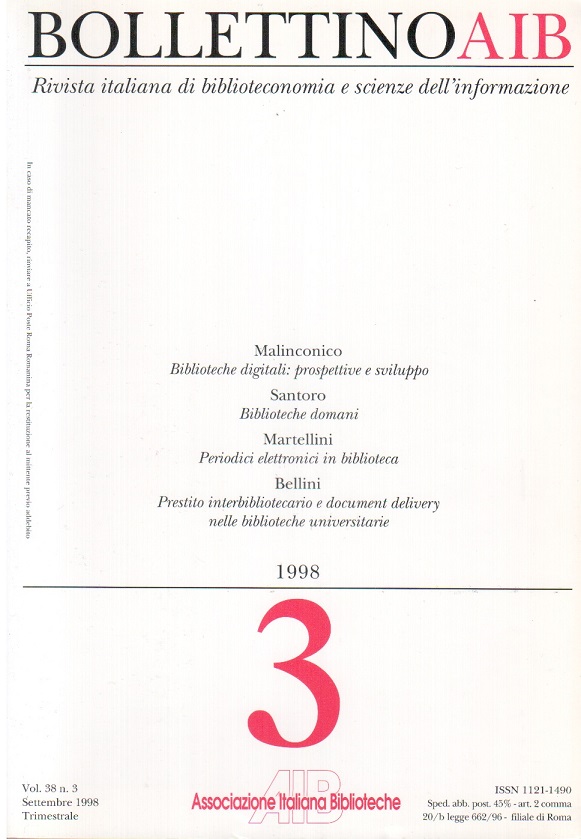Interlibrary loan and document delivery in a medium-sized academic library: statistic analysis and trends
Main Article Content
Abstract
Interlibrary loan/document delivery is today seeing a progressive differentiation. While interlibrary loan in the strict sense remains a transaction between libraries which usually excludes any profit motive, document delivery, understood as the supply of articles from journals, is increasingly seeing the involvement of private suppliers for commercial purposes and tends to directly address the final user, ignoring the library as a go-between.
The ILL/DD service is gaining in importance on traditional services, not only because it is one of the recognised means for ensuring a broader access to information, but also from the point of view of the development of collections, particularly in relation to works in electronic format.
The new importance the ILL/DD service has in today's libraries makes it necessary to extend the range of statistical data which regard it and which should include at least: the number of requests processed, the percentage of satisfied loans, the ratio between loans of original documents and photocopies or other reproductions, the geographical distribution of the applicants and suppliers, the response and supply times, the costs.
The statistical data in this article regard the ILL/DD service at Trento University Library between June 1996 and December 1997 and were collected using a software application developed in house. Trento University Library processes more than 55,300 national and international requests per year in addition to those of the regional library consortium of which it is a member (Catalogo Bibliografico Trentino); part of them (circa 450 per year: 75% photocopies of articles; 25% monographs on loan) regards documents which Trento University Library in turn supplies to other Italian and foreign libraries.
Statistics show that the very irregular trend of requests during the year is related to the principal exam and degree thesis sessions. Survey of the number of requests sent to the various libraries allows us to state that IFLA's recommendations, which suggest turning to different libraries as far as possible, are observed; this is difficult to achieve without a computerised system when dealing with large volumes of loans.
The data on the average document receipt times are very useful also because this is one of the questions which most interests the user when he submits his request. Moreover, they allow one to identify the slowest libraries and to exclude them from those to which one turns. Analysis underscores a progressive reduction in the waiting times for both requests with a positive outcome and those with a negative outcome and a general improvement of the service at national and international level. This improvement is attributable to the greater facility of localising items and the new means of communication, and also to the increasing number of libraries which are activating the ILL/DD service. As regards the waiting times for requests with a positive outcome, the percentage of documents received within 0-60 days rose from 89% in second-half 1996 to 93% in second-half 1997. The shorter times are those necessary to receive the items from the British Library Document Supply Centre (on average 11.7 days by ordinary mail in second-half 1997), the longest those for monographs received via OCLC (on average 42.5 days in the same period).
In the same period, the negative responses received within 30 days rose from 71% to 81%. Here again, the quickest responses were those from the BLDSC (within 48 hours via ARTTel). Nonetheless, the percentage of requests which receive no response remains very high: more than 25% of all those sent. The BLDSC is the most efficient supplier among those used by Trento University Library, also as regards technological innovation. The introduction of the ARTTel system for the forwarding of requests by e-mail has reduced the waiting times also for monographs (from circa 25 days to circa 17 days). The more recent innovations include the introduction of Ariel among the document transmission procedures which Trento University Library proposes to adopt for the requests of some groups of users (the printing of documents nonetheless remains slow and time consuming).
Overall, these statistics show that the interlibrary loan and document delivery service can be improved over time, even when faced with an increase in the requests and staff levels remain constant. This is thanks to the introduction of new communication, data transmission, and item identification tools and also a software which allows the randomness with which a request is forwarded to be reduced over time.
Article Details

This work is licensed under a Creative Commons Attribution-ShareAlike 4.0 International License.
